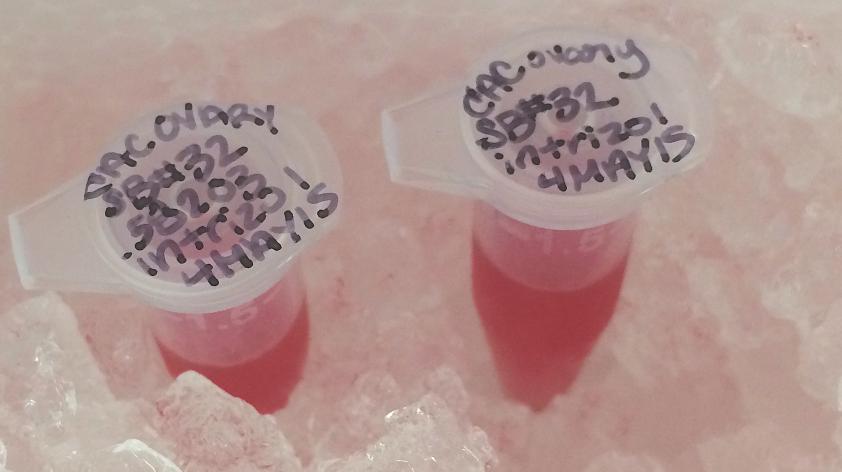
Expanding on a Legacy
While we never welcome the news of the passing of one of our animals, a death can provide researchers in the Reproductive Physiology Division with an abundance of valuable information that can help us lead the fight against extinction. For our gamete unit, reproductive tissues such as ovaries and testes are collected during necropsies (animal autopsies) performed by our Wildlife Disease Laboratories. These tissues are used to develop effective cryopreservation methods that allow us to store samples in our Frozen Zoo® until needed for future assisted reproduction. In the endocrine unit, we use small pieces of tissue to extract genetic material that helps us study how chemicals in the environment negatively impact reproduction of endangered species.
We focus specifically on ribonucleic acid, or RNA, because it is the genetic material that tells a cell how to build all the proteins it needs to function. One way environmental chemicals impair reproduction is to interfere with the proteins in the cells and tissues that make up the reproductive system. We can use the RNA we isolate as a blueprint to synthesize proteins in a test tube, which we then treat with chemicals we suspect to cause reproductive harm and study the interactions between the two. Doing so allows us to pinpoint potentially harmful chemicals without ever exposing an animal to them.
Last year, we received tissues from a very special California condor, Almiyi. Almiyi, was brought to the Zoo in 1983, but not as you might imagine. She began her journey as an egg that was taken from wild along with 3 others to serve as the foundation for the captive breeding efforts that would bring this species back from certain extinction. After she hatched, Almiyi moved to the San Diego Zoo Safari Park where she lived for the next three decades, laying 49 eggs and hatching 38 chicks.
In addition to being the most prolific condor ever, with many of her descendants now living free in California, Arizona and Baja, Almiyi’s portrait famously graced a 1996 postage stamp. Unfortunately, after a 4-month battle with cancer, Almiyi’s long and productive life ended when she was euthanized in May 2015. Although her life came to an end that day, her scientific legacy opened a new chapter when samples of her ovary, oviduct, liver and small intestine were delivered to our lab the following day.
The tissue samples arrive in small, clear plastic tubes filled with a colorless reagent that preserves the very sensitive RNA (Picture 1). Every tissue we collect contains different RNA, each encoding a potential different target of the chemicals we are interested in studying. We start with the most important tissue for us: the ovary. It looks like a miniature bunch of grapes (Picture 2) with each grape carrying an immature egg that has the potential to be fertilized and develop into an embryo. After fertilization, the egg passes through the oviduct (Picture 3), where it receives its shell, and will be laid approximately one month later. The ovary and oviduct are of particular interest to our lab because they contain RNAs that are specifically involved with the regulation of reproduction.
To preserve as much RNA as possible we chop the tissue into small pieces (Picture 4) to insure the RNA preservative reaches all of the tissue. Next, the tissue is digested, liberating the RNA from the tissues. To expedite this process we use a miniature blender, called a homogenizer, to break the tissues into even smaller pieces (Picture 5). From here the broken down tissue with intact RNA is stored at very cold temperate -80°C (-112°F) to keep the RNA stable and safe from degradation (Picture 6).
The research in our lab depends on these small, cold tubes filled with what could be mistaken for a few drops of water. The RNAs we are able to extract from the tissue in these tubes are the building blocks of the specific proteins we are interested in, hormone receptors. We have isolated the RNAs that encode hormone receptors from a number of species; white rhinos, greater one-horned rhinos, polar bears and giant pandas, to name a few, and now we can add condors to the list.
Our work with these fascinating birds focuses on the chemicals they are exposed to by scavenging on marine mammals carcasses along the coast of central California. It is important to understand how these chemicals interfere with their hormone receptors and, ultimately, reproduction. Without samples like Almiyi’s our research would be impossible, because we would have no idea of the structure of condor hormone receptors, much less the ability to synthesize them and study how they interact with harmful chemicals. So while Almiyi has passed, her contributions to the recovery of her species continue, expanding her already impressive legacy.













